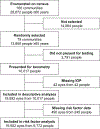Relationship Between Intraocular Pressure and Age: A Population-Based Study in Nepal
- PMID: 37670512
- PMCID: PMC10840987
- DOI: 10.1097/IJG.0000000000002291
Relationship Between Intraocular Pressure and Age: A Population-Based Study in Nepal
Abstract
Prcis: Intraocular pressure (IOP) decreased with age in a population-based study in Nepal, from a mean of 14.1 mm Hg among those 60-64 years old to 13.0 mm Hg among those 80 years old or older.
Purpose: Few studies have assessed the distribution of IOP from the Indian subcontinent, despite its large population and high burden of glaucoma. The objective of this study was to assess the distribution of IOP measurements from adults living in a lowland region of Nepal.
Methods: In a population-based cross-sectional study, all individuals aged 60 years and older from an area of lowland Nepal were invited for an IOP assessment with a rebound tonometer.
Results: Of 160 communities (28,672 people aged ≥60 y) enrolled, 79 (13,808 people aged ≥60 y) were randomly selected for IOP testing. Of those eligible, 10,017 (72.5%) individuals underwent tonometry. Mean IOP decreased monotonically over 5-year age groups, from 14.1 mm Hg (SD: 3.6) among those aged 60-64 years to 13.0 mm Hg (SD: 4.2) among those 80 years or older. The 97.5th percentile IOP measurement was 21.0 mm Hg for all age groups. In adjusted analyses, younger age, self-reported diabetes, and higher population density were each associated with higher IOP, and self-reported cataract surgery was associated with lower IOP.
Conclusions: Mean IOP was lower among older individuals in Nepal, consistent with many studies from East Asia and in contrast to many studies from western populations. These results suggest that ethnic background might be a consideration when diagnosing ocular hypertension.
Copyright © 2023 Wolters Kluwer Health, Inc. All rights reserved.
Conflict of interest statement
Disclosure: The authors declare no conflict of interest.
Figures



Similar articles
-
Device-modified trabeculectomy for glaucoma.Cochrane Database Syst Rev. 2015 Dec 1;2015(12):CD010472. doi: 10.1002/14651858.CD010472.pub2. Cochrane Database Syst Rev. 2015. Update in: Cochrane Database Syst Rev. 2023 Mar 13;3:CD010472. doi: 10.1002/14651858.CD010472.pub3. PMID: 26625212 Free PMC article. Updated.
-
Reliability of Measurements Using Ocular Response Analyzer as a Screening Tonometer and Corneal Hysteresis Values in the Presence or Absence of Glaucomatous Changes in Fundus.J Glaucoma. 2024 Mar 1;33(3):183-188. doi: 10.1097/IJG.0000000000002312. Epub 2023 Sep 12. J Glaucoma. 2024. PMID: 37748090 Free PMC article.
-
Assessment of the iCare HOME2, a New Intraocular Pressure Self-Measurement Tonometer.J Glaucoma. 2023 Nov 1;32(11):926-929. doi: 10.1097/IJG.0000000000002298. Epub 2023 Aug 25. J Glaucoma. 2023. PMID: 37671544
-
Two-Year Clinical Outcomes of the PAUL Glaucoma Implant in White Patients With Refractory Glaucoma.J Glaucoma. 2024 Oct 1;33(10):808-814. doi: 10.1097/IJG.0000000000002457. Epub 2024 Jun 28. J Glaucoma. 2024. PMID: 38940658
-
Fornix-based versus limbal-based conjunctival trabeculectomy flaps for glaucoma.Cochrane Database Syst Rev. 2015 Nov 25;11(11):CD009380. doi: 10.1002/14651858.CD009380.pub2. Cochrane Database Syst Rev. 2015. Update in: Cochrane Database Syst Rev. 2021 Aug 26;8:CD009380. doi: 10.1002/14651858.CD009380.pub3. PMID: 26599668 Free PMC article. Updated.
References
-
- Nemesure B, Honkanen R, Hennis A, et al. Incident open-angle glaucoma and intraocular pressure. Ophthalmology 2007;114:1810–5. - PubMed
-
- Chua J, Tham YC, Liao J, et al. Ethnic differences of intraocular pressure and central corneal thickness: the Singapore Epidemiology of Eye Diseases study. Ophthalmology 2014;121:2013–22. - PubMed
-
- Klein BE, Klein R, Linton KL. Intraocular pressure in an American community. The Beaver Dam Eye Study. Invest Ophthalmol Vis Sci 1992;33:2224–8. - PubMed

